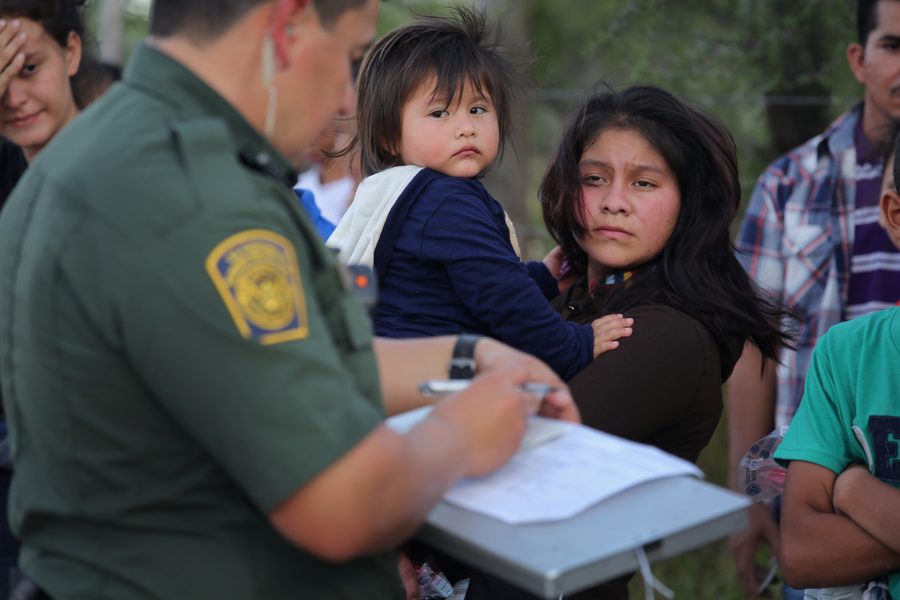Why Abolishing ICE Is Good Climate Policy
The war on terror has unleashed unspeakable cruelty. We must not rely on its institutions to fix the climate crisis.
Kate Aronoff

There’s been a rash of horrific news recently about the treatment of immigrants entering the United States through its southern border. According to Department of Homeland Security (DHS) statistics obtained and published by The Associated Press on Friday, nearly 2,000 children were forcibly separated from their parents within just six weeks between April and May. That follows Attorney General Jeff Sessions’announcement of a “zero-tolerance” policy on immigration, to criminally prosecute cases of illegal entry into the United States and incarcerate children and their parents in separate facilities.
Without realizing it, Jeff Sessions wrote a climate policy. As climate-fueled migration continues to accelerate, immigration policies will determine how the U.S. government navigates the climate crisis. For now, policymakers’ playbook is the war on terror, and its tools are the hapless, barbaric institutions created to wage it.
With Sessions’new mandate, the Department of Justice (DOJ) has created a problem the U.S. government is incapable of handling. To deal with the sudden influx of young prisoners — some ripped crying from their parents’arms — the administration is now constructing ad-hoc prisons in converted Wal-Marts and tent cities, like the one built to house 360 kids in Tornillo, Texas. The DOJ also ruled that people fleeing domestic abuse or any kind of non-governmental violence will no longer be eligible for asylum, effectively recasting gender-based violence as a private rather than a public matter.
This week’s onslaught of immigration news offers a chilling preview of events that could become all the more likely as the planet warms. At the core of the immigration debate is the question that will come to dominate the climate-defined politics of the 21st century: Who gets to live here and live well?
New warming, new walls
Nearly every policy field will be shaped by rising temperatures in the coming decades, and immigration will almost certainly be among those most deeply impacted. By 2080, climate-related causes could send as many as 6.7 million people to the United States from Mexico alone. Overall projections for climate-fueled migration vary widely, though they generally predict that somewhere between 25 million and 1 billion people will be displaced in the coming decades — by leaps and bounds, the largest mass migration event in world history.
These changes are already starting to play out. Central American farmers have for years been forced northward thanks to a combination of prolonged drought and increasingly neoliberal agricultural policies in the region, in some cases brought about by International Monetary Fund (IMF)-imposed structural adjustment packages. The North American Free Trade Agreement (NAFTA) flooded Mexico with U.S.-subsidized corn almost as soon as it passed, devastating that country’s agricultural economy and forcing many to pursue work elsewhere, often in factories along the borderlands or in the United States. Following NAFTA’s passage and the ensuing surge in immigration, then-president Bill Clinton doubled the budget of the Immigration and Naturalization Service and swelled security forces and technology along the border.
Within the United States, as journalist Todd Miller has noted, internal migration resulting from unbearable heat and catastrophic storms and fires could soon be treated as an excuse for immigration officials to erect new barriers to basic resources and state protections. In his book Storming the Wall, Miler imagines a scenario in which the majority-Latino population of Phoenix is forced to flee through interstate checkpoints controlled by Border Patrol agents. “Borders can be enacted quickly through road blockades and interrogating agents,” he contends, noting that during the Depression farmers fleeing the Dust Bowl were blocked from entering California.
Indeed, new borders are already proliferating in the 21st century. Since its creation in 2003 as part of the war on terror, the Immigration and Customs Enforcement (ICE) has effectively extended the militarized southern border into towns and cities throughout the United States, to often terrifying ends for those targeted.
“To be in the United States without legal immigration status is to be subject to potential deportation. That’s been a truth of immigration law forever. It’s just that for most of U.S. history, it was mostly a hypothetical truth,”writes Vox immigration reporter Dara Lind. “The federal government just didn’t have the resources for interior immigration enforcement to pick up and remove large numbers of immigrants who hadn’t committed other crimes.” ICE’s inception made it far more likely that someone could be picked up — say in a routine traffic stop, at their workplace or school or from their own home — and deported, forced at a Kafkaesque moment’s notice to leave behind families and communities.
As writer and researcher Sean McElwee points out in his call to abolish the agency, ICE since its founding has operated more or less by the principles of counterinsurgency — staying all too true to its post-9/11 roots. Targeted raids on its outspoken critics are intended to chill opposition to the agency, spread fear within immigrant communities and encourage obedience. As acting ICE director Thomas Honan warned, “You should look over your shoulder, and you need to be worried.”
Today’s immigration policies are deeply bound up in the war on terror ethos: the commitment to military interventionism abroad and emboldened xenophobia at home that’s been a mainstay of the Bush, Obama and Trump administrations. And just as draconian immigration policies aren’t unique to the Trump White House, federal agencies under both Democratic and Republican control have been meticulously planning for climate change for years. The Pentagon has been writing reports about how climate change could impact U.S. defense interests since 1992, dubbing it a “threat multiplier” that poses “immediate risks” to national security, and even listing climate change as a top national security threat in its 2014 Quadrennial Defense Review. Defense Secretary James Mattis told the Senate Armed Services Committee that climate change is already “impacting stability in areas of the world where our troops are operating today,” and has long argued that the military should wean itself off of fossil fuels.
A 2007 report from the Center for Naval Analysis (CNA) Corporation, authored by a panel of retired generals, takes a similar approach. Its authors recommend that the “national security consequences of climate change” be “fully integrated into national security and national defense strategies.” The panel’s greatest concern by far is the risk of climate-fueled migration. “More poverty, more forced migrations, higher unemployment. Those conditions are ripe for extremists and terrorists,” writes retired Admiral T. Joseph Lopez, former top NATO commander in Bosnia. “Climate change will provide the conditions that will extend the war on terror.” Similarly, retired Air Force General Chuck Wald predicts that the U.S. military will “be drawn into the politics of Africa, to a much greater extent than we have in the past”t hanks to mass migration and growing conflicts over resources on that continent.
In its relatively sober look at the realities of climate change, the defense community seems to view warming as cause for continued military intervention. The widely-cited Age of Consequences report on the subject recommends that the Pentagon moves to increase the “resilience of the international community against climate-related threats by strengthening the governance, healthcare, and disaster prevention and relief capabilities of foreign countries,” laying out a kind of climate-conscious White Man’s Burden. If you all you have is a hammer, evidently, everything looks like a nail.
Indeed, much of the academic and policy literature around climate change and security posits migrating populations — those from the Global South, especially — as a threat. In The Coming Anarchy, renowned political scientist Robert Kaplan argues that environmental changes will force respectable nations to defend themselves on a “rundown, crowded planet of skinhead Cossacks and juju warriors, influenced by the worst refuse of Western pop culture and ancient tribal hatreds and battling over scraps of overused earth in guerrilla conflicts that ripple across continents.”
The warming we’re already locked-in to experience — and that many places are experiencing already — is playing out in a world marked by staggering inequality and conflict, largely rooted in Cold War-era militarism and geopolitical divides. In his book Tropic of Chaos, Journalist and geographer Christian Parenti calls this phenomenon a catastrophic convergence, where “problems compound and amplify each other, one expressing itself through another.” The real horror of climate change isn’t that there’s something inherently monstrous about hurricanes, forest fires or sea level rise, but that the ways governments respond to them (or don’t) could be totally disastrous for a supermajority of the world’s population. Parenti calls this the “politics of the armed lifeboat: the preparations for open-ended counterinsurgency, militarized borders, aggressive anti-immigrant policing and a mainstream proliferation of right-wing xenophobia.”
Fortress environmentalism
Yet despite the clear ties, immigration has tended to be something of a blind spot for many environmentalists — or worse. Even self-described radicals within the big green tent have flirted with misanthropic Malthusianism, pinpointing overpopulation as a main driver of climate change. Dave Foreman, founder of the radical direct action group Earth First!, reliably aligns himself with white supremacists in calling for restrictive immigration policies. And while hardly anti-immigrant in its own right, one of the founding texts of modern environmentalism—Limits to Growth—outlines a basic contradiction between expanding populations and material prosperity that xenophobic elements within the green movement have seized upon to call for harsher border security measures.
Some environmental groups have even praised arms of the military for their clear-eyed stance on climate, drawing a contrasts between Pentagon positions on climate and those of the White House. “Mattis,”the Natural Resources Defense Council raved, “not only believes in climate change but believes it’s making his job harder … apparently not even clearly worded warnings from his own defense secretary are enough to sway Donald Trump on this matter.” In a Veterans Day blog post in 2017, Sierra Club Board president Loren Blackford wrote that “many military leaders see an urgency in transitioning to renewable energy,” and praised Mattis for urging the military “to move away from oil and toward green technologies in order to help reduce the threat of attacks on fuels supplies. Here at home, more military bases are converting to renewable energy because it makes them more resilient, independent, and powerful.”
Such arguments may inadvertently end up empowering our bloated, destructive national security apparatus to decide how America responds to climate change. Rather than appealing to Trump to listen to James “Mad Dog” Mattis about global warming, climate hawks might do well to put more ambitious demands on the table: Abolishing ICE, and dismantling the Department of Homeland Security.
It’s not a difficult case to make. DHS is a Frankenstein monster of a federal agency, an amalgamation of 22 federal agencies cobbled together in the months after 9/11. The New Republic’s Matt Ford points out that DHS is responsible for too many things to do any of them well, with a mandate that includes everything from cyber-security to disaster response to borders. “The department,” Ford contends, “will always be the hastily assembled product of a dark, paranoid moment in American history. It also helps give permanence to that moment, preventing the country from moving beyond the post-9/11 era.”
Of particular concern to climate activists should be the fact that FEMA, housed under DHS, is notoriously incompetent at handling catastrophic events. Then-director Michael Brown famously bungling the federal response to Hurricane Katrina, to deadly effect. And an extensive Politico investigation found that the agency reliably prioritized Texas’recovery from Hurricane Harvey over Puerto Rico’s from Hurricane Maria, despite the fact that the damage to the island dwarfed that done in the greater Houston area. “Nine days after the respective hurricanes, FEMA had approved $141.8 million in individual assistance to Harvey victims, versus just $6.2 million for Maria victims,” author Danny Vinik wrote. Within the same time period after each storm, the federal government sent a third of the personnel it had sent to the Houston region to Puerto Rico. FEMA was also responsible for handing out a scandalous contract to an Atlanta-based entrepreneur to deliver 30 million meals — only 50,000 of which materialized before the contract was cancelled.
It’s hard to imagine what a just and effective U.S. governmental response to the climate crisis might look like. It’s even harder to imagine DHS being a part of it, either in dealing acutely with catastrophic weather or over the long-term with increasing flows of climate migrants. Yet as temperatures continue to rise, the military and the combined capacities of DHS stand as America’s frontline responders to direct and indirect climate impacts. If allowed to continue, this reality stands to create a kind of climate apartheid, endowing an overtly political government agency with the power to decide who gets to recover from devastating storms and floods, and which families are allowed to stay together.
The strategy behind the war on terror has driven, not mitigated, violence, and provided the basis for unspeakably cruel immigration policies. Why should we expect it to be any better at dealing with climate change? Let’s dismantle DHS instead of giving it license to deploy its trademark mix of incompetence and cruelty on a warming world.
Kate Aronoff is a staff writer at The New Republic and author of Overheated: How Capitalism Broke the Planet — And How We Fight Back. She is co-author of A Planet To Win: Why We Need a Green New Deal and co-editor of We Own the Future: Democratic Socialism—American Style. Follow her on Twitter @katearonoff.








